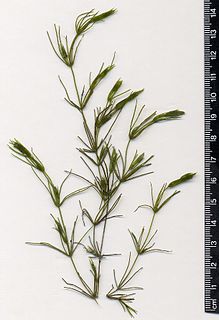| Halimedaceae | |
|---|---|
 | |
| Scientific classification | |
| (unranked): | Viridiplantae |
| Division: | Chlorophyta |
| Class: | Ulvophyceae |
| Order: | Bryopsidales |
| Family: | Halimedaceae Link, 1832 |
| Genera | |
Halimedaceae are a family of green algae in the order Bryopsidales. [2]
| Halimedaceae | |
|---|---|
 | |
| Scientific classification | |
| (unranked): | Viridiplantae |
| Division: | Chlorophyta |
| Class: | Ulvophyceae |
| Order: | Bryopsidales |
| Family: | Halimedaceae Link, 1832 |
| Genera | |
Halimedaceae are a family of green algae in the order Bryopsidales. [2]

Charales is an order of freshwater green algae in the division Charophyta, class Charophyceae, commonly known as stoneworts. Depending on the treatment of the genus Nitellopsis, living (extant) species are placed into either one family (Characeae) or two. Further families are used for fossil members of the order. Linnaeus established the genus Chara in 1753.

Halimeda is a genus of green macroalgae. The algal body (thallus) is composed of calcified green segments. Calcium carbonate is deposited in its tissues, making it inedible to most herbivores. However one species, Halimeda tuna, was described as pleasant to eat with oil, vinegar, and salt.

AlgaeBase is a global species database of information on all groups of algae, as well as one group of flowering plants, the sea-grasses.

Ectocarpales is a very large order in the brown algae. The order includes families with pseudoparenchymatous (Splachnidiaceae) or true parenchymatous (Scytosiphonaceae) tissue. Pseudoparenchymatous refers to a filamentous alga with cells packed very close together to give an appearance of parenchymatous tissue, the latter being composed of cells which can truly divide in three dimensions, unusual among the algae. Filamentous algae are composed of cells that divide along a single plane, allowing only elongation to form filaments of one or more rows of cells. Algae that can divide in two planes can form sheet-like thalli or bodies. Cells that can divide in a third plane potentially allow for the organism to develop a more complex body plan, and diversification of body plans into an erect thallus of some sort and a holdfast for attaching the upright portion to the substrate.

Caulerpaceae is a family of green algae in the order Bryopsidales.

Udoteaceae is a family of green algae, in the order Bryopsidales.
Rhipiliopsis is a genus of green algae in the family Rhipiliaceae. Johnson-sea-linkia is a synonym.
The Mesostigmatophyceae are a class of basal green algae found in freshwater. In a narrow circumscription, the class contains a single genus, Mesostigma. AlgaeBase then places the order within its circumscription of Charophyta. A clade containing Chlorokybus and Spirotaenia may either be added, or treated as a sister, with Chlorokybus placed in a separate class, Chlorokybophyceae. When broadly circumscribed, Mesostigmatophyceae may be placed as sister to all other green algae, or as sister to all Streptophyta.
Chlorokybus is a multicellular (sarcinoid) genus of basal green algae or charophyte, a soil alga. It has been classified as the sole member of the family Chlorokybaceae, which is the sole member of the order Chlorokybales, in turn the sole member of the class Chlorokybophyceae.
Mesostigma is a genus of freshwater green algae, with a single species Mesostigma viride. As of February 2022, AlgaeBase classified it as the only genus in the family Mesostigmataceae, the only family in the order Mesostigmatales, the only order in the class Mesostigmatophyceae. It is now considered to be one of the earliest diverging members of green plants/algae (Viridiplantae).

The Rivulariaceae are a family of cyanobacteria within the Nostocales in which the filaments (trichomes) are tapered from wider at the base to narrower at the tip.
Onslowiaceae is the only family in order Onslowiales in the brown algae. The family contains only the genera Onslowia and Verosphacela.

Ralfsiales is an order of crustose brown algae containing two families.

Klebsormidiales is an order of charophyte algae. It is the only order in the class Klebsormidiophyceae. As of February 2022, AlgaeBase accepted two families in the order:
Sycidiales is an order of fossil charophyte green algae. The reproductive structures in Sycidales have a calcified cover, called a utricle, that is thought to prevent the zygote being dessiccated. Other Paleozoic families lack this cover, as do modern charophytes. Fossils of the family Sycidiaceae are found over the longest time span, from the Silurian to the Carboniferous.
Trochiliscaceae is a family of fossil charophyte green algae. It is the only member of the order Trochiliscales. The reproductive structures in Trochiliscaceae have a calcified cover, called a utricle, that is thought to prevent the zygote being desiccated. Other Paleozoic families lack this cover, as do modern charophytes. Fossils of Trochiliscaceae are from the Devonian.